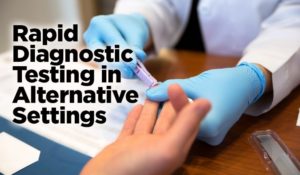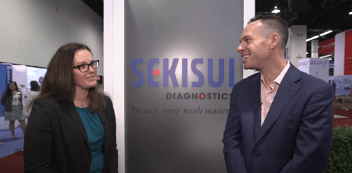It happens every year – respiratory season arrives to gum up the works of doctor’s offices across the country. While respiratory diseases can be as mild as a common cold, they can also lead to hospitalizations or worse if left unchecked.

As respiratory season gets closer, it’s important for healthcare professionals to be able to accurately understand and diagnose the differences between viruses like respiratory syncytial virus and adenovirus. While they share many similarities, they can manifest themselves in very different ways.
Adenoviruses can cause a wide range of signs and symptoms, such as: common cold or flu-like symptoms, fever, sore throat, acute bronchitis, pneumonia, pink eye, acute gastroenteritis.1
Adenoviruses can cause a wide range of signs and symptoms, such as: common cold or flu-like symptoms, fever, sore throat, acute bronchitis, pneumonia, pink eye, acute gastroenteritis.1
RSV usually causes mild symptoms, but can cause severe illness in infants, some young children, and older adults. The CDC recommends a single dose of RSV vaccine to protect all adults ages 75 and older and adults ages 60-74 who are at increased risk of severe RSV. It’s often recognized as one of the most common causes of childhood illness and is the most common cause of hospitalization in infants.2
While both viruses share many similarities, it’s important to understand how they differ. RSV and adenovirus are associated with mild to severe respiratory infection and are indistinguishable during the acute phases of the illnesses. However, outcome and long-term prognosis are different with both infections. RSV infection is associated with later development of asthma, and adenovirus with severe lung damage, bronchiectasis, and hyperlucent lung.3
In this blog, we are going to discuss the clinical challenges with differentiating between these two viruses, the role of rapid testing in improving diagnosis and treatment, and the potential impact of these diagnostics on patient outcomes and public health.
The Clinical Challenges of Differentiating Between Adenovirus and RSV
Because of the similarities in symptoms between adenovirus and RSV, it can be hard to diagnose accurately. It’s important for providers to be able to understand the differences and similarities between these viruses to provide the best patient care.
Signs and symptoms of RSV infection appear mostly about four to six days after exposure to the virus. For adults and children, RSV usually causes mild cold-like signs and symptoms. RSV can also spread to the lower respiratory tract, which can cause pneumonia or bronchitis.4
Adenovirus is frequently accompanied by small, single-stranded DNA parvoviruses known as adeno-associated viruses, that don't seem to cause any specific disease. In fact, most experimental gene therapies have switched from using adenoviruses to these adeno-associated viruses to mitigate some of the side effects. Most adenovirus infections are asymptomatic, and when they do cause symptoms, these are mostly mild.5
Because of the mild severity of these symptoms, many people with adenovirus infections do not require treatment. Those that need treatment might be looking at control of nasal secretions with saline washes and suctioning, and breathing treatments if needed. However, in some people, adenovirus can lead to severe disease and even death. People who have respiratory failure or severe GI symptoms, hepatitis, myocarditis or encephalitis or people who have low immune function, may need hospitalization and treatment with an antiviral medication called cidofovir.6
The Role of Rapid Testing in Accurate Diagnosis
Rapid diagnostic tests have become an incredible tool for providers to give quick and accurate diagnoses, without the need to wait for lab results to come back. There are several advantages to opting for rapid testing, as opposed to the traditional laboratory testing process:
- Rapid testing provides fast results. This may allow you to get treatment faster. Faster treatment can reduce the severity of your symptoms and may help prevent the spread of disease.
- Rapid tests are easy to use. They can be done by non-medical workers and volunteers who have been trained to do the test. Many patients even perform rapid diagnostic tests on themselves.
- Rapid tests require little or no special equipment required. This advantage is especially useful in areas with limited resources or access to specialized labs.7
Rapid diagnostic tests also play an instrumental role in curbing and reducing the spread of respiratory infection – they can be used for early case identification, surveillance and case management, and are critical for initiating deployment of vaccine and monoclonal antibodies.8
SEKISUI Diagnostics has a specific diagnostic testing solution for detecting RSV and adenovirus. The OSOM® RSV/Adeno test is a rapid chromatographic immunoassay for the qualitative detection of RSV and/or Adenovirus antigens directly from nasal swabs or nasal suction fluid in patients suspected of having a viral respiratory infection. Throat swabs are also an acceptable sample type for the detection of Adenovirus antigens.9
Understanding how the difference between adenovirus and RSV can affect your patients is critical to their safety during respiratory season. SEKISUI Diagnostics is committed to strengthening patient outcomes by focusing on innovating and developing highly accurate diagnostic tests, reagents, and systems.
References
- About Adenovirus, CDC
- Clinical Overview of RSV, CDC
- Differential effects of respiratory syncytial virus and adenovirus on mononuclear cell cytokine responses, National Library of Medicine
- Respiratory syncytial virus (RSV), Mayo Clinic
- Which Respiratory Virus Do I Have?, MedPage Today
- Adenovirus Infection and Outbreaks: What You Need to Know, American Thoracic Society
- Rapid Tests, MedlinePlus
- Rapid diagnostic test: a critical need for outbreak preparedness and response for high priority pathogens, BMJ Global Health
- OSOM® RSV/Adeno Test, SEKISUI Diagnostics



Share Article